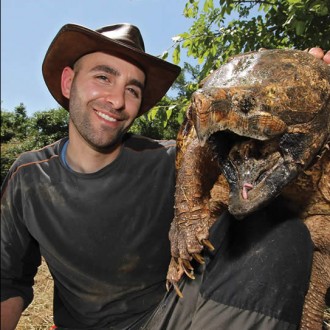After I wolfed down a peanut butter and jelly sandwich at lunchtime, their trusting request was repeated, “Go outside. Be back for supper.” I always returned, as instructed, right before our dinner plates landed on the table. My childhood wasn’t perfect, but in some respects it was downright glorious. I was an adventure seeker and outdoor enthusiast before I knew my ABCs.
Today, parents often shudder when I tell them about my upbringing. “But you could have been kidnapped!” they sputter with wide eyes. “What if you had been hurt? Or worse!”
Back then, hypotheticals did not drive parenting. Good judgement may have been partially off the table too, but our parents placed their faith in us. Plus, we didn’t have a multitude of electronics and fifty stations of infinite cartoons. We had to find ways to keep ourselves busy, and there was no better place to do that than the great outdoors.
Coyote Peterson, animal expert and host of “Brave Wilderness,” had a similar upbringing. He spent much of his childhood exploring the woods behind his home in the small town of Newbury, Ohio. There, a simple love of animals and appreciation for the outdoors gave him inspiration for his hit YouTube channel and new book “Brave Adventures: Wild Animals in a Wild World.”

“From those early days, I told my Mom that I wanted to have my own reptile show some day. I wanted to be the one to show other people this incredible world that I had come to love and respect,” Peterson reveals in the prologue.
In short standalone chapters, he recalls some of his most memorable encounters with creatures from all over the world and the environments in which they live. From his first spontaneous moment with a snapping turtle at eight years old to the many nail-biting adventures with his Brave Wilderness team, the book reminds us that animals rule the wild places of this planet. But, according to Peterson, that shouldn’t stop parents from encouraging their kids to explore beyond their front doors. There are plenty of ways for your child to “Be Brave, Stay Wild,” as Peterson says at the end of each “Brave Wilderness” episode.
He recommends that children start in their own backyards where the opportunities are endless yet often hidden. “Anybody who has rocks or logs or trees, anything like that around their house, you can go outside and find some sort of an animal. Even if it’s something as simple as a beetle or a worm, it’s still exciting.”
He’s also a fan of local and state parks, which are affordable and accessible for families of all sizes. “They have beautifully manicured trails and posted directions, making it a safe adventure for any family,” he says. Once children are a little older, in the 10 to 15 age range, adventures can become more challenging and ambitious. Backcountry backpacking, “spending at least one night in the wilderness, usually at a designated backcountry campsite or trail shelter far from the nearest road,” is a good starting point.

If your child is fearful of or intimidated by nature, Peterson suggests reading as a gateway. He was inspired by books such as “20,000 Leagues Under the Sea,” “Misty of Chincoteague,” and “Jaws,” and spent a considerable amount of time learning about different species from encyclopedias and other wilderness guides at his local library.
When exploring the outdoors, proper identification of animal species, Peterson explains, is the most important thing you and your child can do to stay safe. “You can walk upon something and be like, ‘Wow, that is a really cool looking snake.’ But it could venomous. It could kill you,” he warns. Peterson encourages kids to admire animals from a safe distance, but also realizes that curiosity sometimes gets the best of us.
“Obviously people are curious by nature, especially kids, and they’re going to want to catch things, they’re going to want to handle them, they’re going to want to get a closer look,” says Peterson.
In each show, Peterson travels the world teaching his audience about and interacting with earth’s most dangerous, abstract, and misunderstood animals. On occasion, he even endures bites, stings, pinches, and barbs to show viewers how the human body reacts and how to remedy the different situations.
Even so, he urges caution and education. “You can get incredibly close to things and not touch something and have the same intimate and meaningful encounter with an animal without ever disturbing it in its natural environment,” he says.


